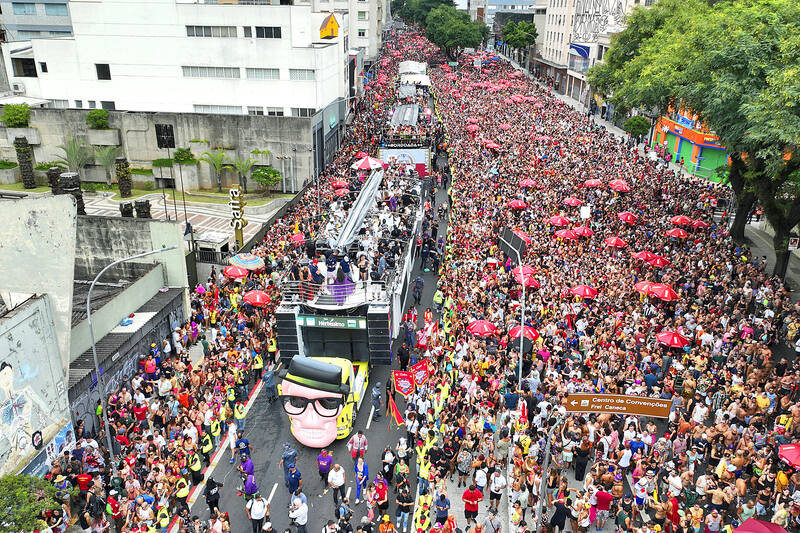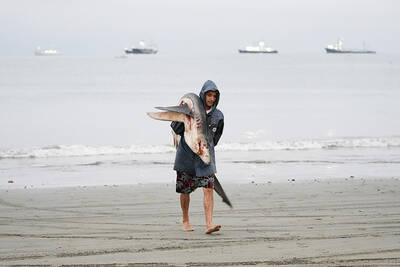Sound begins blasting ear drums and rattling bones even before the speakers — hauled by big rigs creeping their way through Brazil’s thronging carnival crowds — draw near.
The behemoth sound trucks known as electric trios are a Brazilian innovation that amplified music and effectively did away with front-row seats — making carnival more accessible. In the seven decades since the first one hit Brazil’s streets, they have become a fixture of the country’s annual pre-Lenten festivities and draw millions to the streets. Singer Caetano Veloso’s ode to the earth-shaking vehicles proclaimed that the only people not following them must already be dead.
From Salvador, on Brazil’s northeast coast, trios spread throughout the country and found more disciples; an Instagram account that posts seemingly banal videos of the nation’s rigs has about 150,000 followers, with fans praising each trio’s merits. They have grown ever-more sophisticated and ever larger — with lights, LED screens, dressing rooms and VIP areas.

Photo: AP
Their appeal has never been just the novelty of amplification.
Their steady, constant advance meant anyone, rich or poor, could get close enough to the music to feel it throb through their body, said Isaac Edington, who coordinates Salvador’s festivities as president of its tourism agency.
Helen Salgado, a 31-year-old actress, traveled to Salvador from Rio to immerse herself in the oceans of people churning around trios in celebrations ahead of the official start of carnival on Saturday. She said she was driven to ecstasy without consuming so much as a drop of alcohol.
“It was very loud ... and marvelous,” Salgado said by phone, laughing. “I think that’s why there’s all this frenzy: The sound dominates you and intoxicates you.”
But long before these walls of sound took Brazil by storm, there was a Ford. It was a 1929 Model A — the Model T’s lesser-known successor — imported from the US to Salvador. For years, metalworker Osmar Macedo used the convertible to haul iron.
In 1950, Osmar, as he is universally known, and his friend Dodo, a radio technician and fellow amateur musician, outfitted the Ford with two speakers and connected their guitar and cavaquinho to the car’s battery, said Aroldo Macedo, Osmar’s son.
They drove the car, with its dented fender and chipping maroon paint, through the streets playing music and delighting carnival revelers who jumped and jived in their wake, he said.
The duo repeated the stunt the next year, this time with a third musician, and so called themselves the Trio Eletrico.
The term stuck, and was applied to all mobile stages that rolled across Salvador, the capital of Bahia state. Soon enough, trios were the centerpiece of the city’s carnival.
They started featuring Bahia’s top artists, like Veloso, who clambered aboard one built specially for him in 1972 that resembled a spaceship. They became launchpads for the careers of musicians, including Daniela Mercury, Ivete Sangalo and Margareth Menezes, Brazil’s current culture minister, who called the trio “one of Brazil’s great inventions.”
“It was a great revolution in the carnival of the people, the carnival of the street,” Menezes said by phone from Salvador, where she’s preparing the Trio of Culture that will feature herself alongside Gilberto Gil and Chico Cesar. “Everyone wants to shake themselves to the sound of the electric trio.”
That popular spirit is at the heart of carnival, which is not just about cutting loose; it also represents the subversion of established order and roving street parties are a manifestation of the people taking control of the city.
Salvador’s trios were a guiding light for Rio when street parties re-emerged after Brazil cast off its military dictatorship in 1985, said Rita Fernandes, president of the Sebastiana association that organizes some of the city’s most traditional parties.
Rick Mello’s Rick Sound provides trios for more than two dozen street parties in Rio and also rents the trucks to samba schools rehearsing for the traditional Sambadrome parade. There were 11 trios shoehorned into his warehouse last month — and he said he could not run full sound tests inside because the clamor, reaching up to 180 decibels, could blow out an eardrum.
“Compared to Bahia, this is a Volkswagen Beetle,” Mello said, referring to his biggest truck, which has 60 speakers. “But one day we’ll get there.”
Perhaps the best known of all the trios was the Dragon. Salvador-based band Asa de Aguia (Eagle’s Wing) performed atop the truck for years and immortalized it in a song as “the biggest electric trio on the planet.”
However, the Dragon was a handful. Its 30m length made cornering a feat, and at 5.5m tall, it often snagged power lines and toppled utility poles when touring to Rio or Sao Paulo for gigs, said Jose Mario Bordonal, whose company bought it a decade ago.
Bordonal and his siblings founded their company to build sound trucks in their tiny hometown in Sao Paulo’s rural interior, Cravinhos.
Their first trio upset the order of things about 35 years ago, with a wild street party for the working class that lured even the well-heeled to forgo a private carnival soiree, Bordonal said.
The police, and the soiree’s organizer, were furious.
About a quarter-century later, the Dragon caused fresh ruckus.
“When it got to Cravinhos ... it entered the first street, and it pulled down two poles right away,” Bordonal said.
He modified the Dragon’s axles to make cornering easier and reduced its height — but extended its length to 34m.
Bordonal eventually sold it, and has since built a bigger trio whose 200 speakers blasted Sao Paulo’s biggest street party of the carnival season on Sunday last week — and he has plans for an even larger one.
However, Salvador’s vast fleet makes it the unrivaled kingdom. During carnival this year, as many as 70 are to plod through the swarming crowds each day, Edington said.
Rio has roughly that amount through all of carnival, its tourism agency said.
In a tribute to the trios’ forebears, Salvador’s two main trio routes are named for Osmar and Dodo, and a replica of their Ford appears atop one of the mammoth rigs.
Coming full circle from the imported Ford that became Brazil’s first trio, singer Claudia Leitte is in the process of dispatching a trio to the US.
Leitte, who once sang atop a trio for seven hours straight, intends to bring a Salvador-style carnival to Miami’s Ocean Drive.

Russia and Ukraine have exchanged prisoners of war in the latest such swap that saw the release of hundreds of captives and was brokered with the help of the United Arab Emirates (UAE), officials said on Monday. Ukrainian President Volodymyr Zelenskiy said that 189 Ukrainian prisoners, including military personnel, border guards and national guards — along with two civilians — were freed. He thanked the UAE for helping negotiate the exchange. The Russian Ministry of Defense said that 150 Russian troops were freed from captivity as part of the exchange in which each side released 150 people. The reason for the discrepancy in numbers

BLOODSHED: North Koreans take extreme measures to avoid being taken prisoner and sometimes execute their own forces, Ukrainian President Volodymyr Zelenskiy said Ukrainian President Volodymyr Zelenskiy on Saturday said that Russian and North Korean forces sustained heavy losses in fighting in Russia’s southern Kursk region. Ukrainian and Western assessments say that about 11,000 North Korean troops are deployed in the Kursk region, where Ukrainian forces occupy swathes of territory after staging a mass cross-border incursion in August last year. In his nightly video address, Zelenskiy quoted a report from Ukrainian Commander-in-Chief Oleksandr Syrskyi as saying that the battles had taken place near the village of Makhnovka, not far from the Ukrainian border. “In battles yesterday and today near just one village, Makhnovka,

A shark attack off Egypt’s Red Sea coast killed a tourist and injured another, authorities said on Sunday, with an Italian Ministry of Foreign Affairs source identifying both as Italian nationals. “Two foreigners were attacked by a shark in the northern Marsa Alam area, which led to the injury of one and the death of the other,” the Egyptian Ministry of Environment said in a statement. A source at the Italian foreign ministry said that the man killed was a 48-year-old resident of Rome. The injured man was 69 years old. They were both taken to hospital in Port Ghalib, about 50km north

The foreign ministers of Germany, France and Poland on Tuesday expressed concern about “the political crisis” in Georgia, two days after Mikheil Kavelashvili was formally inaugurated as president of the South Caucasus nation, cementing the ruling party’s grip in what the opposition calls a blow to the country’s EU aspirations and a victory for former imperial ruler Russia. “We strongly condemn last week’s violence against peaceful protesters, media and opposition leaders, and recall Georgian authorities’ responsibility to respect human rights and protect fundamental freedoms, including the freedom to assembly and media freedom,” the three ministers wrote in a joint statement. In reaction